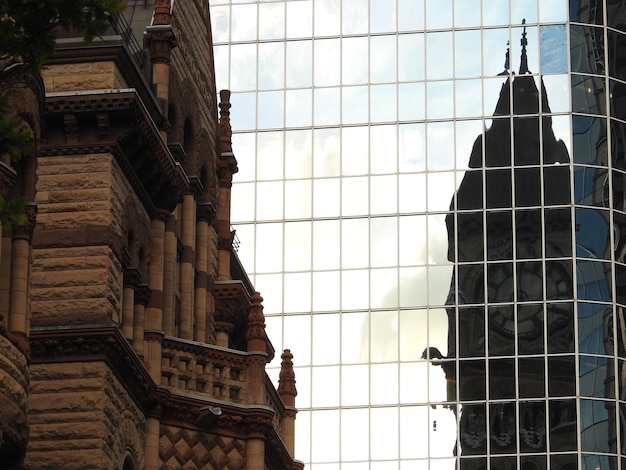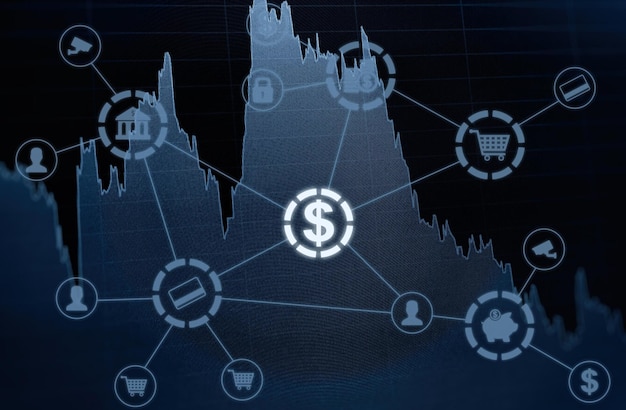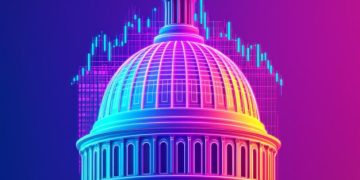Federal Reserve Interest Rate Hike: Impacts on Consumers & Businesses

A Federal Reserve interest rate hike influences consumers and businesses by raising borrowing costs, which can affect spending, investment, and overall economic activity in the US.
The Federal Reserve interest rate hike is a significant event that sends ripples throughout the economy, impacting both consumers and businesses. Understanding these effects is crucial for navigating the financial landscape.
What is a Federal Reserve Interest Rate Hike?
A Federal Reserve interest rate hike refers to an increase in the federal funds rate, the target rate banks charge each other for overnight lending of reserves. This rate is a key tool used by the Federal Reserve (also known as the Fed) to influence economic activity.
When the Fed raises interest rates, it becomes more expensive for banks to borrow money. These increased costs are then passed on to consumers and businesses in the form of higher interest rates for loans, mortgages, and other forms of credit.

How the Federal Funds Rate Works
The federal funds rate is determined by the Federal Open Market Committee (FOMC), which meets regularly to assess the state of the economy and decide monetary policy. The FOMC sets a target range for the federal funds rate and uses open market operations to influence the actual rate.
Open market operations involve the buying and selling of U.S. government securities in the open market. When the Fed buys securities, it injects money into the banking system, increasing the supply of reserves and putting downward pressure on the federal funds rate. Conversely, when the Fed sells securities, it withdraws money from the banking system, decreasing the supply of reserves and putting upward pressure on the rate.
- Target Range: The FOMC sets a target range rather than a fixed rate to provide flexibility in managing monetary policy.
- Open Market Operations: These operations are the primary tool used to maintain the federal funds rate within the target range.
- Influence on the Economy: Changes in the federal funds rate influence borrowing costs, investment decisions, and overall economic activity.
In conclusion, a Federal Reserve interest rate hike is a deliberate action to manage inflation and maintain economic stability by adjusting the cost of borrowing money throughout the financial system.
Impact on Consumers: Borrowing and Spending
For consumers, a Federal Reserve interest rate hike primarily affects the cost of borrowing money. This influence can alter spending habits and financial decisions.
Higher interest rates mean that loans, mortgages, and credit card debt become more expensive. This can lead to reduced spending as consumers allocate more of their income to debt repayment rather than discretionary purchases.
Mortgage Rates and Home Buying
One of the most significant impacts of a Fed rate hike is on mortgage rates. As interest rates rise, the cost of borrowing for a home increases, making it more expensive to buy a house. This can cool down the housing market as demand decreases.
Potential homebuyers may find themselves priced out of the market or decide to postpone their purchase until rates become more favorable. Existing homeowners with adjustable-rate mortgages may see their monthly payments increase as their interest rates adjust to the new environment.
Credit Card Debt and Personal Loans
Credit card debt is another area where consumers feel the impact of rising interest rates. Credit card interest rates are typically variable, meaning they can change in response to changes in the Fed’s benchmark rate. As rates rise, the cost of carrying a balance on a credit card increases, making it more expensive to finance purchases over time.
Similarly, personal loans, auto loans, and other forms of consumer credit become more expensive. This can discourage consumers from taking on new debt and may lead them to reduce their spending on non-essential items.

- Increased Borrowing Costs: Higher interest rates across various forms of credit lead to increased borrowing costs for consumers.
- Reduced Spending: Consumers may reduce their spending as they allocate more of their income to debt repayment.
- Housing Market Impact: Rising mortgage rates can cool down the housing market and make home buying more expensive.
In summary, Federal Reserve interest rate hikes influence consumer behavior by increasing borrowing costs, which can lead to reduced spending and altered financial decisions regarding mortgages, credit cards, and personal loans.
Effects on Businesses: Investment and Growth
Businesses also feel the effects of a Federal Reserve interest rate hike, particularly in terms of investment and growth. The cost of capital increases, impacting decisions related to expansion, hiring, and capital expenditures.
When the Fed raises rates, it becomes more expensive for businesses to borrow money for investment. This can lead to a slowdown in capital expenditures and a more cautious approach to expansion.
Cost of Capital and Investment Decisions
The cost of capital is a critical factor in businesses’ investment decisions. Higher interest rates increase the cost of borrowing, making it more expensive to finance new projects, equipment purchases, and expansions. This can lead businesses to postpone or cancel investments, impacting overall economic growth.
Businesses may also become more selective in their investment choices, prioritizing projects with the highest potential returns and delaying those with lower returns or higher risk. This can result in a shift in investment patterns and a slowdown in overall capital spending.
Hiring and Employment
Rising interest rates can also affect businesses’ hiring decisions. As the cost of capital increases and economic growth slows, businesses may become more cautious about hiring new employees. They may also delay or reduce planned expansions, leading to a slowdown in job creation.
Small businesses, in particular, may be vulnerable to the effects of rising interest rates. They often rely on borrowing to finance their operations and may find it more difficult to access credit as rates rise. This can lead to financial strain and potentially result in layoffs or business closures.
- Increased Cost of Capital: Higher interest rates increase the cost of borrowing for businesses, impacting investment decisions.
- Slowdown in Investment: Businesses may postpone or cancel investments due to increased borrowing costs.
- Impact on Hiring: Rising rates can lead to a slowdown in job creation as businesses become more cautious about hiring.
In conclusion, Federal Reserve interest rate hikes impact businesses by increasing the cost of capital, which can lead to a slowdown in investment, more selective project prioritization, and a cautious approach to hiring and expansion.
The Fed’s Perspective: Controlling Inflation
The Federal Reserve primarily uses interest rate hikes as a tool to control inflation. Inflation refers to the rate at which the general level of prices for goods and services is rising, and subsequently, purchasing power is falling.
By raising interest rates, the Fed aims to reduce aggregate demand and slow down economic growth, thereby preventing the economy from overheating and prices from rising too quickly.
The Relationship Between Interest Rates and Inflation
When the economy is growing too rapidly, demand for goods and services may outstrip supply, leading to rising prices. In this scenario, the Fed may raise interest rates to cool down economic activity and bring inflation back to its target level. Higher interest rates discourage borrowing and spending, which can help to curb excess demand and ease inflationary pressures.
The Fed typically aims for an inflation rate of around 2%. This level is considered consistent with price stability and sustainable economic growth. When inflation exceeds this target, the Fed may take action to tighten monetary policy by raising interest rates.
Historical Examples of Rate Hikes to Curb Inflation
Throughout history, the Federal Reserve has used interest rate hikes to combat inflation. For example, in the 1980s, then-Fed Chairman Paul Volcker implemented aggressive rate hikes to bring down double-digit inflation rates. While this policy led to a recession in the short term, it was ultimately successful in restoring price stability.
More recently, the Fed has used rate hikes to manage inflation during periods of economic expansion. These actions are intended to prevent the economy from overheating and to maintain a stable and sustainable growth path.
- Inflation Control: The Fed primarily uses interest rate hikes to control inflation by reducing aggregate demand.
- Target Inflation Rate: The Fed typically aims for an inflation rate of around 2% for price stability and sustainable growth.
- Historical Examples: The Fed has historically used rate hikes to combat inflation, as seen in the 1980s and more recent economic expansions.
In summary, the Fed raises interest rates primarily to control inflation, aiming for a target rate of around 2%. This measure is designed to reduce aggregate demand and cool down economic activity, preventing the economy from overheating and ensuring price stability.
Alternative Actions by the Federal Reserve
While raising interest rates is a common tool, the Federal Reserve has other methods at its disposal to influence the economy. These alternative actions can be used in conjunction with or instead of rate hikes, offering a range of options to manage economic conditions.
These alternatives include adjusting the reserve requirements, using quantitative easing, and providing forward guidance. Each of these actions has its own unique effects on the economy and may be more appropriate in certain circumstances.
Adjusting Reserve Requirements
Reserve requirements refer to the fraction of a bank’s deposits that it is required to keep in its account at the Fed or as vault cash. By adjusting reserve requirements, the Fed can influence the amount of money that banks have available to lend. Lowering reserve requirements increases the amount of money banks can lend, while raising them decreases the amount.
Changes in reserve requirements can have a significant impact on the money supply and the availability of credit. However, the Fed typically adjusts reserve requirements infrequently, as they can be disruptive to bank operations. Changes to the reserve requirement are rare.
Quantitative Easing (QE)
Quantitative easing (QE) involves the Fed purchasing long-term government securities or other assets in the open market. This increases the money supply and lowers long-term interest rates, stimulating economic activity.
QE is often used when short-term interest rates are already near zero, and the economy needs additional stimulus. QE can help to lower borrowing costs for businesses and consumers, encouraging investment and spending. QE can also lead to inflation, so the fed must be careful when using this tool.
- Adjusting Reserve Requirements: Influences the amount of money banks can lend by changing the fraction of deposits they must hold in reserve.
- Quantitative Easing (QE): Involves the Fed purchasing long-term securities to increase the money supply and lower long-term interest rates.
- Forward Guidance: Involves the Fed communicating its intentions, what conditions would cause it to maintain a course of action, and what conditions would cause it to change course.
In summary, the Federal Reserve can influence the economy through adjusting reserve requirements and using quantitative easing practices. These practices can offer a range of options to manage economic conditions.
Strategies for Consumers and Businesses
Given the potential impacts of Federal Reserve interest rate hikes, it’s essential for both consumers and businesses to adopt strategies that can help them navigate the changing financial landscape. Proactive measures can mitigate risks and take advantage of new opportunities.
For consumers, these strategies may include reducing debt, managing expenses, and exploring alternative financing options. For businesses, they may involve optimizing capital structures, improving efficiency, and diversifying revenue streams.
For Consumers: Reducing Debt and Managing Expenses
One of the most effective strategies for consumers is to reduce debt, particularly high-interest debt such as credit card balances. Consumers can prioritize paying down debt to reduce their exposure to rising interest rates. It is also advisable to use debt consolidation to lock in rates before they increase.
Managing expenses is another key strategy. Consumers can review their budgets and identify areas where they can cut back on spending. This can help them free up more of their income for debt repayment or savings.
For Businesses: Optimizing Capital Structures
Businesses can optimize their capital structures to reduce their reliance on debt financing or look at fixed rate loans. This may involve restructuring debt, issuing equity, or retaining earnings. Optimizing capital structures can help businesses reduce their vulnerability to rising interest rates and improve their financial stability.
Improving efficiency is another important strategy. Businesses can focus on streamlining their operations, reducing costs, and improving productivity. This can help them increase their profitability and generate more cash flow, reducing their reliance on borrowing. Businesses should also diversify their services to continue to grow.
- Consumers: Strategies for consumers include reducing debt, managing expenses, and exploring alternative financing options.
- Businesses: For optimize capital structures, improving efficiency, and diversifying revenue streams are viable options.
In summary, both consumers and businesses can adopt several strategies to navigate the changing financial landscape resulting from interest rate hikes. Consumers can focus on managing their expenses, while businesses often lean towards optimizing structures and improving their efficiency.
| Key Point | Brief Description |
|---|---|
| ⬆️ Rate Hikes | Increase borrowing costs for consumers and businesses. |
| 🏠 Housing Impact | Mortgage rates rise, cooling the housing market. |
| 💲 Business Investment | Cost of capital increases, leading to cautious investment. |
| 🛡️ Consumer Strategies | Reducing debt and managing expenses. |
Frequently Asked Questions
▼
It’s an increase in the federal funds rate, influencing borrowing costs for banks, consumers, and businesses across the country.
▼
Rising mortgage rates can make buying a home more expensive. Existing homeowners with adjustable rates may also see increased monthly payments.
▼
Businesses can optimize capital structures by reducing their reliance on debt financing and improving operational efficiency to lower costs.
▼
The Federal Reserve raises rates primarily to control inflation and maintain economic stability by reducing aggregate demand.
▼
Yes, the Fed can adjust reserve requirements or implement quantitative easing to manage economic conditions instead of raising interest rates.
Conclusion
Understanding the implications of a Federal Reserve interest rate hike is essential for both consumers and businesses. By staying informed and adopting proactive strategies, you can navigate the changing financial landscape and position yourself for success.





